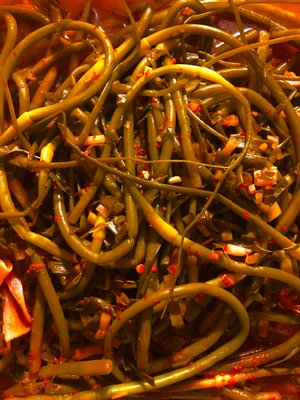
While we’re on the topic of pickles, a fermentation conversation would be incomplete without a nod to kimchi. A Korean staple made from salted, fermented vegetables, the condiment’s origin stretches back to 37 BC; some 13th century poetry actually invokes kimchi. As the Korean poet Yi Gyuobo wrote, around that time, “The roots in the earth grow plumper every day / Harvesting after the frost, a slice cut by a knife tastes like a pear.” In short: preserving seasonal bounty has been going on for a long, long, long time.
Kimchi can be made from any vegetables or fruits, really, though the traditional incarnations include the high water content and leafy napa cabbage, as well as the mild-flavored daikon radish. But Almond Chef Jeremy Blutstein wants you to know that kimchi can stretch the boundaries of the American imagination.
“Substitute whatever vegetables you want,” he said. “You want something with structure, as far as the greens are concerned. Something with a rib in it: Beet greens will hold up quite well. I [recently] made a garlic scape kimchi.” The scape pickle bubbled away, happily, in a 39-degree walk-in refrigerator in the restaurant’s basement. It had spent some time at room temperature, which kick-started its fermentation. The long, curled scapes (the beginning of the garlic plant, which are harvested in spring and can be eaten in their entirety) were a pale green and smelled predictably pungent, not unlike sauerkraut.
Most kimchi recipes call for the Korean spice gochagaru, which is, essentially, a chili pepper flake. For those who can’t find this somewhat obscure spice, crushed red pepper can be used instead. “It’s going to be different,” said Chef Blutstein. Not bad—just different. “The Korean chili heat is a little more well rounded. It’s warmer.
“The whole world ferments,” he continued, “whether it’s Eastern European Jews doing cabbage or Southeast Asians doing fish sauce [which is produced from fermented squid]. It’s a living organism. It’s constantly evolving.” That’s an important point to remember with any kind of pickle: Pickles are alive. They’re mutable. They change with the weather, literally. A warm, humid environment will produce fermentation more readily than a cool, dry environment. Like wine, which changes in the presence of wild yeast, pickles, too, can change. “Things are a product of their environment,” Chef Blutstein said. “There are intangibles that you can’t account for.”
Chef Blutstein also wants home cooks to throw caution to the wind. Americans don’t leave eggs and butter out, he reminded me, whereas Europeans do. Americans are taught to refrigerate first and ask questions later. Keep it cold! Fear time and temperature! But the truth is, fermentation does its best work in warmer environments. The comforting chill of a Sub-Zero will mute the complex flavors otherwise developed on one’s kitchen counter.
Traditional kimchi is made in clay pots and left out to ferment in the sun. While this might be taking the premise a little too far, home chefs striving for a complex, homemade version of this condiment should take it to the counter. Let kimchi be at room temperature for 12 to 24 hours before transferring it to the fridge. Enthusiastic traditionalists can go all the way, substituting fish sauce for dried shrimp and scallops (available at Asian specialty stores). On occasion, Chef Blutstein saves the scallop feet from sea scallops, dries them, smokes them, and adds them in lieu of dried shellfish.
It’s not a complicated pickle, and it’s not expensive, either. Everything needed to make kimchi can be found, for a little more than a song, at the local grocery store (or stock up on local radishes and cabbage when they’re in season). Anything firm and with a little natural sugar to it will do: Asian pear, radish, kohlrabi, garlic, onion and scapes are a few familiar options. And once its done, the condiment will hold for a good long while.
Here in New York, where seasons are swift and the bounty is momentary, pickling is just another way to make the summer last. “What’s our season?” Chef Blutstein asks. “The reality is that people don’t really think that anything grows 12 months out of the year. So what do you do? You preserve it. Preserving the harvest is real, and fermentation is the easiest way to do it.”
Chef Jeremy Blutstein’s Napa Cabbage And Daikon Radish Kimchi(Yields 2 pounds)2 pounds napa cabbage, thinly sliced
1/2 pound daikon radish or other radish, sliced
1/4 cup salt
1 tablespoon ginger, peeled and chopped
1 tablespoon chopped garlic
1 tablespoon sugar
2 tablespoons gochugaru chili flakes (or crushed red pepper flakes, if you prefer)
1/2 onion, sliced
1 bunch scallions
4 ounces fish sauce You will need a large Ball jar—64 ounces will work well—in which to make your kimchi.
Salt the cabbage and radish and leave them at room temperature, uncovered, for 12 hours.
Combine the softened vegetables with the remaining ingredients. Mix to combine. Place them in the Ball jar and leave them uncovered at room temperature for an additional 12 hours.
Cover the mixture and place in the refrigerator. It should spend two to three weeks refrigerated before use. Check on it periodically to make sure that it is bubbling (a sign of fermentation).